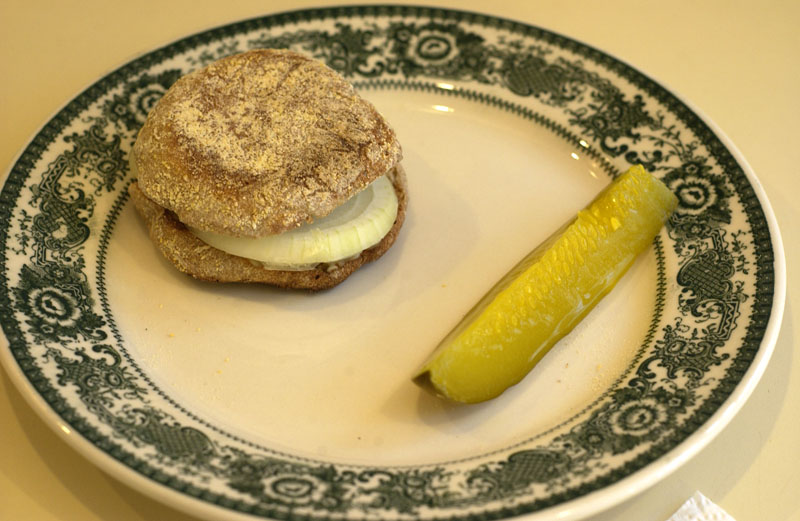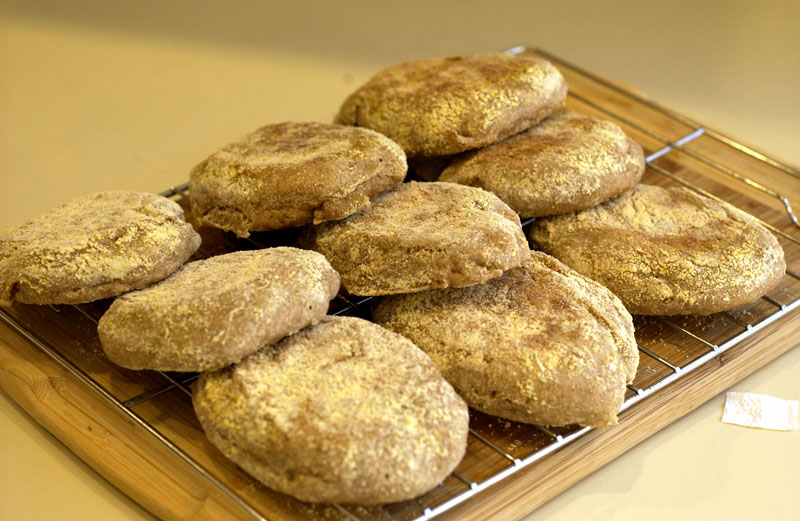
Onion sandwich on English muffin
During the heat of summer, I slacked off on baking. On a shopping trip to Whole Foods, I broke down and bought some English muffins. They were addictive, so I resolved to start making them when cooler weather returned.
The English muffins from Whole Foods were only marginally decent. They were made largely with white flour. At least the texture was right. I was foolish enough, while feeding my addiction, to try Thomas English muffins from a regular grocery store. They were totally not edible. I should have composted them, but I gave them to the chickens. For one, they contained all kinds of adulterants, including fats and emulsifiers (in the form of mono- and diglycerides) to give the bread that horrible brioche-y, cake-like texture that the hordes of non-coastal America seem to like so much. You know, Wonder bread. Or, in these parts, Bunny bread.
As a matter of fact, when we quote Marie Antoinette as saying, “Let them eat cake,” what she really said, in French, was, “S’ils n’ont pas de pain, qu’ils mange de la brioche!” As pure language, that translates to, “If they don’t have bread, let them eat brioche!” Brioche, of course, is bread — a soft cake-like bread. Culturally, this is probably not translatable, but I strongly suspect that the reference to brioche contained an insult to the type of bread peasants preferred, if they could get it.
Anyway, English muffins take a long time to make, and they’re a pain in the neck. But they have many virtues. For one, because they’re destined for the toaster, they can be put in a bag, popped in the fridge, and kept for days. Fresh from the toaster, you’d never know they were made five days ago. For two, if you make them yourself, the best ones are 100 percent fat free, unlike their competitor for breakfast bread — biscuits.
If you want to make English muffins, I’d recommend starting with this recipe from King Arthur Flour and modifying it to your taste. But notice that even King Arthur brioche-ifies the dough with egg, butter, and sugar. Horrible! I make my dough with nothing but whole wheat flour, water, yeast, and a bit of sugar to feed the yeast. For a proper bread texture, you can’t go wrong with those simple ingredients in your dough.
I think I’ll also make some bagels this fall. It’s been many years since I’ve made bagels, but they’re not much more trouble than English muffins.



3 Comments
Have you made Bannocks? Scottish oatcakes similar to these muffins but with oatmeal and/or oat flour–I have substituted part whole wheat flour in my recipe and usually bake them in a 400 oven but I think the traditional oatcakes were cooked on a lightly greased griddle on the stove as you have.
1 c rolled oats
here’s the recipe:
1 c rolled oats
1 c oat flour (caa process regular rolled oats for a minute or so. Substitute part whole wheat flour if desired)
4 Tbsp butter ( or margarine or whatever strange concoction you find nowadays in the dairy case)
1/2 c water
pinch of salt
Mix/knead ingredients together or put in food processor. Divide into 2 lumps and roll out about 1/2 inch thick, cut into quarters, prick with fork a few times–helps honey or jam adhere later when eating! Bake at 400 for about 20 minutes or until lightly browned. Experiment with cooking on stovetop as for english muffins, seems it would work OK. This batter is pretty stiff.
Sounds good, especially if mixed with some whole wheat…
Post a Comment